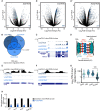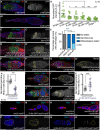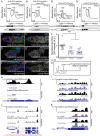Msl3 promotes germline stem cell differentiation in female Drosophila
- PMID: 34878097
- PMCID: PMC8783043
- DOI: 10.1242/dev.199625
Msl3 promotes germline stem cell differentiation in female Drosophila
Abstract
Gamete formation from germline stem cells (GSCs) is essential for sexual reproduction. However, the regulation of GSC differentiation is incompletely understood. Set2, which deposits H3K36me3 modifications, is required for GSC differentiation during Drosophila oogenesis. We discovered that the H3K36me3 reader Male-specific lethal 3 (Msl3) and histone acetyltransferase complex Ada2a-containing (ATAC) cooperate with Set2 to regulate GSC differentiation in female Drosophila. Msl3, acting independently of the rest of the male-specific lethal complex, promotes transcription of genes, including a germline-enriched ribosomal protein S19 paralog RpS19b. RpS19b upregulation is required for translation of RNA-binding Fox protein 1 (Rbfox1), a known meiotic cell cycle entry factor. Thus, Msl3 regulates GSC differentiation by modulating translation of a key factor that promotes transition to an oocyte fate.
Keywords: Differentiation; Meiosis; Msl3; RpS19; Set2 and Rbfox1.
© 2022. Published by The Company of Biologists Ltd.
Conflict of interest statement
Competing interests The authors declare no competing or financial interests.
Figures







Similar articles
-
MSL complex is attracted to genes marked by H3K36 trimethylation using a sequence-independent mechanism.Mol Cell. 2007 Oct 12;28(1):121-33. doi: 10.1016/j.molcel.2007.08.011. Mol Cell. 2007. PMID: 17936709
-
Mago Nashi and Tsunagi/Y14, respectively, regulate Drosophila germline stem cell differentiation and oocyte specification.Dev Biol. 2007 Aug 15;308(2):507-19. doi: 10.1016/j.ydbio.2007.06.007. Epub 2007 Jun 13. Dev Biol. 2007. PMID: 17628520 Free PMC article.
-
Loss of function of male-specific lethal 3 (Msl3) does not affect spermatogenesis in rodents.Dev Dyn. 2024 May;253(5):453-466. doi: 10.1002/dvdy.669. Epub 2023 Oct 17. Dev Dyn. 2024. PMID: 37847071 Free PMC article.
-
Post-transcriptional gene regulation regulates germline stem cell to oocyte transition during Drosophila oogenesis.Curr Top Dev Biol. 2020;140:3-34. doi: 10.1016/bs.ctdb.2019.10.003. Epub 2019 Nov 27. Curr Top Dev Biol. 2020. PMID: 32591078 Review.
-
Role of Chromatin Modifications in Drosophila Germline Stem Cell Differentiation.Results Probl Cell Differ. 2017;59:1-30. doi: 10.1007/978-3-319-44820-6_1. Results Probl Cell Differ. 2017. PMID: 28247044 Review.
Cited by
-
Set2 and H3K36 regulate the Drosophila male X chromosome in a context-specific manner, independent from MSL complex spreading.bioRxiv [Preprint]. 2024 May 6:2024.05.03.592390. doi: 10.1101/2024.05.03.592390. bioRxiv. 2024. Update in: Genetics. 2024 Oct 17:iyae168. doi: 10.1093/genetics/iyae168. PMID: 38766267 Free PMC article. Updated. Preprint.
-
Set2 and H3K36 regulate the Drosophila male X chromosome in a context-specific manner, independent from MSL complex spreading.Genetics. 2024 Oct 17;228(4):iyae168. doi: 10.1093/genetics/iyae168. Online ahead of print. Genetics. 2024. PMID: 39417694
-
TORC1-driven translation of Nucleoporin44A promotes chromatin remodeling and germ cell-to-maternal transition in Drosophila.bioRxiv [Preprint]. 2025 Mar 16:2025.03.14.643309. doi: 10.1101/2025.03.14.643309. bioRxiv. 2025. PMID: 40161787 Free PMC article. Preprint.
-
Genome organization regulates nuclear pore complex formation and promotes differentiation during Drosophila oogenesis.Genes Dev. 2024 Jun 25;38(9-10):436-454. doi: 10.1101/gad.351402.123. Genes Dev. 2024. PMID: 38866556 Free PMC article.
-
Genome organization regulates nuclear pore complex formation and promotes differentiation during Drosophila oogenesis.bioRxiv [Preprint]. 2023 Nov 16:2023.11.15.567233. doi: 10.1101/2023.11.15.567233. bioRxiv. 2023. Update in: Genes Dev. 2024 Jun 25;38(9-10):436-454. doi: 10.1101/gad.351402.123. PMID: 38014330 Free PMC article. Updated. Preprint.
References
-
- Anderson, L. K., Royer, S. M., Page, S. L., McKim, K. S., Lai, A., Lilly, M. A. and Hawley, R. S. (2005). Juxtaposition of C(2)M and the transverse filament protein C(3)G within the central region of Drosophila synaptonemal complex. Proc. Natl. Acad. Sci. U.S.A. 102, 4482-4487. 10.1073/pnas.0500172102 - DOI - PMC - PubMed
Publication types
MeSH terms
Substances
Grants and funding
LinkOut - more resources
Full Text Sources
Molecular Biology Databases
Research Materials
Miscellaneous

